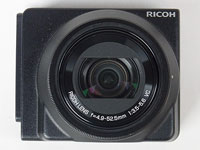Ricoh GXR: Camera Unit P10
Introduction to the P10 28-300 Camera Unit | Photos of the Camera Unit Attached to the Body | Add-Ons | Experiences | Conclusions | Links
Archive
On this page, I collect information about the Ricoh GXR P10 camera unit, also called lensor or module.
Introduction to the P10 28-300 Camera Unit
The P10 camera unit is more or less a CX2/3/4/5/6 in a GXR body, that is, a CX with a number of additional features: RAW format, manual settings, an EVF for people like me, who do not like to use an LCD screen, and more. Thus, it has the same focal range of 28-300 (4.9-52.5 mm) and a tiny 1/2.3-inch CMOS sensor (total pixels: approx. 10.60 million pixels) like Ricoh's compact cameras (the CX2 offers only a range of 28-200 mm equivalent). Like its compact counterparts, it offers a useful macro function, which is even more flexible than that of the S10 camera unit and offers higher magnification than the A12-50 camera unit (more than 1:2). This camera unit is probably the most flexible of all GXR camera units, but due to its tiny sensor also the one with the lowest image quality.
Photo: Ricoh Lens P10 28-300 mm equiv. F3.5-5.6 VC
This camera unit allows to capture videos in HD 720p format.
BTW: VC in the module name indicates that this module has vibration correction (sensor shift) - regrettably not the better one from the CX4.
Photos of the Camera Unit Attached to the Body
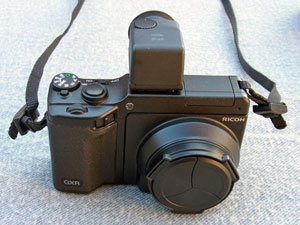 |
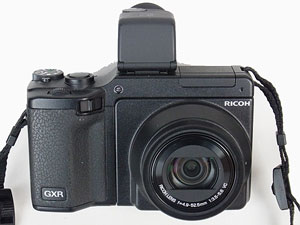 |
Photos: Body with P10 camera unit attached - with LC-2 lens cap (left)
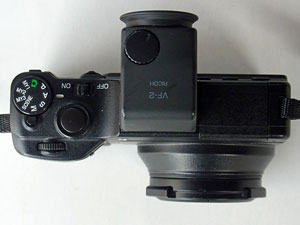 |
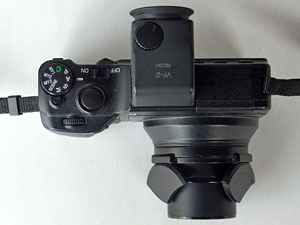 |
Photos: Top view of body with P10 camera unit attached - "off" (left) and "on" (right)
Add-Ons
The following add-ons are available for the P10 unit and have to be bought separately (see also photos below):
- Lens Cap LC-2: A lens cap with three movable segments that does not need to be put off when the unit is used
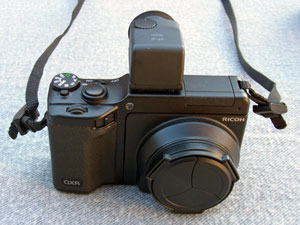 |
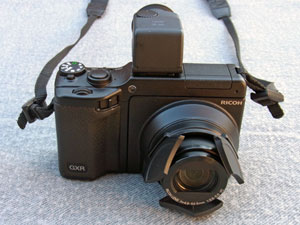 |
Photos: Body with P10 camera unit attached and with LC-2 lens cap and "off" (left) and "on" (right)
Experiences
Long ago, I bought one of the first "super" zooms with a focal range of 28-200 mm for my analog Canon A1. In the new millennium, I switched from Nikon to the Minolta Dimage 7 series of bridge cameras having the same focal range. When I stepped up to DSLRs, I bought a Sigma 18-200 lens, featuring an equivalent focal range of 28-300 mm. Now, I own a P10 module with just the same focal range of 28-300 (4.9-52.5 mm) and a tiny 1/2.3-inch CMOS sensor (total pixels: approx. 10.60 million pixels). Thus, in a certain sense, I have returned to where I had been before, and in another one not, because this is a small sensor module.
I also led my wife to use Ricoh cameras, starting with a focal range of 28-200 mm. In 2010, she stepped up from her CX1 to a CX4, which also has a focal range of 28-300 mm (this range was introduced with the CX3). Thus, with the P10 unit, I have a camera very similar in operation to my wife's one. There are, however, some important differences:
- The GXR is much more bulkier than the CX3ff. While the latter easily fits a pocket, the GXR/P10 combo does not, particularly, when I use it with the electronic viewfinder VF-2.
- For me it is mandatory that there is an electronic (or optical) viewfinder that I can use at eye-level (so I need not use glasses). The CXff has only an LCD screen that can often be hard to use in direct sunlight.
- The GXR offers RAW, a capability that has often been demanded for the R/CX series, but never materialized...
- The GXR also offers manual settings (A, S, and M mode) which the R/CX series does not offer (the recent CX6 offers some sort of A and S modes)
- Some forum posters state that the overall image quality of the P10 is slightly better than that of the CX series.
As already mentioned, the P10 camera unit is more or less a CX2/3/4/5/6 in a GXR body, that is, a GXR with a number of added features: RAW format, manual settings, an EVF for people like me, who do not like to use an LCD screen, and more. On the other hand, it is a small sensor camera, meaning large field of depth, noise, and smear. Having the smallest sensor of all camera units, it also offers the lowest image quality and also has a slightly different rendering of colors than the other units (which are also not identical).
But if you are not too picky regarding image quality, this unit is really useful, flexible, fast, and fun. I like the fairly huge focal range, leading me to take many more tele shots than in the recent past (and like in the not so recent past), I like its macro abilities, particularly in the tele range, and I hope I will like its speed and features like dynamic range (DR) and multi-focus for macros. But I still have to use these features, which I know already from my wife's CXes.
The LC-2 lens cap can be used on the P10 unit as well: it can be kept on the lens while shooting. However, if you want to have the luxury of a lens cap that does not need to be pulled off when shooting you have to buy it separately (or steel it from an S10 if available...).
Perhaps a few words to the macro mode. When Ricoh made its R series of digicams slimmer with the introduction of the R6, minimum macro distance at the tele end moved from 15 cm to 25 cm, thus reducing the possible magnification and making tele macro more or less useless. When they introduced the CX2, they extended tele to 300 mm ad possible also changed the minimum macro distance at 200 mm. At 300 mm, Ricoh reports a minimum distance of 28 cm, which seems to indicate that it became smaller at 200 mm. I cannot prove this yet, but my P10 module reports a minimum distance of 10 cm for 200 mm and autofocus (it is even a little bit smaller for manual focus). Up to 300 mm, minimum distance increases fast to 27 cm. As a consequence of this change, tele macro has become much more usable again, and I use it a lot. Magnification seems only a tiny bit less than at wide angle.
In the meantime and owning the A12-28 camera unit as well, I have regrettably become somewhat spoilt by the superior quality and sharpness of the A12 units and find the images taken with the P10 module fuzzy. There are also definite differences in how the APS-C units render faces and other details compared with the small-sensor units (and the respective point-and-shoot cameras from Ricoh). All this lead me to not using this camera unit for a long time. So, maybe one day, I will get rid of my small sensor units (I sold already the S10)...
Conclusions
This camera unit is very versatile with its focal range of 28-300 equiv. and good macro abilities - the most flexible in Ricoh's current line of units. It has deficits in image quality, but may still be sufficient in many cases. I also found this unit of little use in low light situations (wedding in dark town hall, Christening in dark church, ...) because it either smears too much at high ISO or creates fuzzy images because of long exposure times at lower ISO. In such situations, I prefer using my A12 units at ISO 1600.
In the long run, however, I was spoilt by the image quality of my APS-C camera units and do not use the P10 camera unit any more...
Links
Ricoh Links
- Technical data: ricoh.com/r_dc/gxr/specs.html#08
- Description: ricoh.com/r_dc/gxr/unit3.html (German: ricoh.com/r_dc/de/gxr/unit3.html)
Links to Pages on this Site
- My Equipment
- Macro Comparisons
- ISO Comparisons (S10 and A12-50; and a few P10)
- A12-28 Comparisons: A12-28 versus P10, S10 (includes P10)
- P10 Converters Experiments
- Issues (only some of the issues refer to the P10)
| 19.11.2020 |
